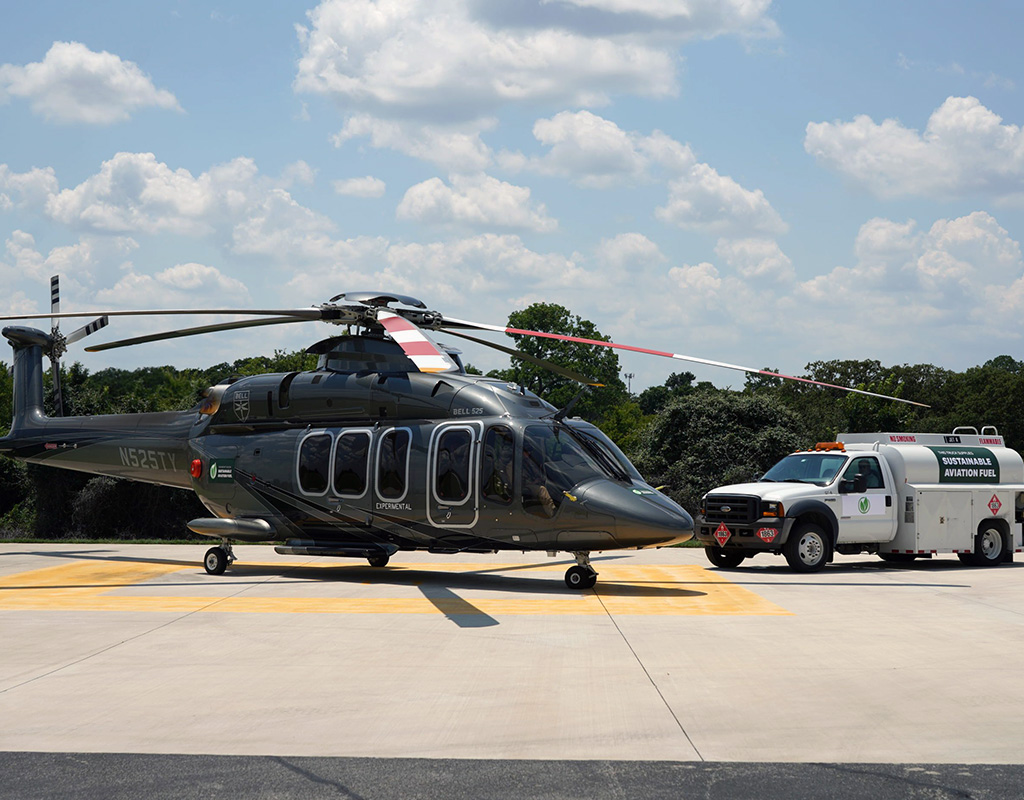
On World Earth Day, Bell is celebrating its commitment to become a sustainability leader in the aviation industry, from the way its aircraft are operated to its manufacturing processes.
Last year Bell made vast strides in the implementation of Sustainable Aviation Fuel (SAF) by operating its aircraft on the low-carbon fuel. In March 2021, Bell announced the incorporation of SAF into its entire Bell Training Academy (BTA) and customer demonstration fleet of aircraft. That same year, in November 2021, Bell announced the completion of the first flight using SAF with the Bell 525, an aircraft which already offers significant reduction in fuel consumption compared to other aircraft in its class. Combined with the successful incorporation of SAF, the Bell 525’s green credentials will offer a host of benefits for future customers including the offshore industry.
Bell is the first rotorcraft manufacturer to partner with Avfuel Corporation to use its Neste MY SAF which uses 100% renewable and sustainably sourced waste and residue materials. Avfuel estimates its SAF can cut greenhouse gas emission by up to 80% and once blended at a 35% ratio, has the potential to reduce life cycle carbon emissions by 22-metric tons per truck load.
“Bell has taken an important step in seeking more sustainable solutions for rotorcraft. Customer feedback has proven that SAF is a viable alternative that does not necessitate customers modifying their aircraft,” said Doug May, vice president, Customer Experience.
“We anticipate SAF will gain popularity as the aerospace industry continues to incorporate more solutions to reduce carbon emissions.”
In March, Safran Helicopter Engines and Bell announced a collaboration. The initiative explores technical performance and economic impacts of SAF on the Arrius 2R-powered Bell 505. Both Bell and Safran Helicopter Engines will evaluate engine and aircraft performance data to better assess the collateral benefits associated with the incorporation of SAF, with a single, dedicated Bell 505 aircraft to conduct flights solely with the use of the blended fuel.
However, the use of SAF is not the only step Bell is taking to benchmark sustainability standards in the aviation industry. In 2020, as part of its Achieve 2025 initiative, Textron established a new set of five-year sustainability goals, including a 20% reduction in greenhouse emissions, a reduction in energy and water use intensity by 10% and also a reduction of waste generation by 10%.
In 2020 alone, Textron operations around the globe were able to complete 145 sustainability projects aimed at energy, waste or water use reduction. In addition to saving Textron over $2 million, these projects helped Textron increase energy efficiency and reduce greenhouse gas emissions, water use and waste generation. Project savings on energy were over 40,000 mmBTUs, which resulted in reducing greenhouse gas emissions by over 5,500 metric tons.
Textron has also joined the Renewable Energy Buyers Alliance (REBA). REBA is an alliance of large clean energy buyers, energy providers, and service providers that, together with NGO partners, are working to support access to renewable energy.
Alongside the Achieve 2025 initiative, Bell has invested significant resources into developing increasingly sustainable technology. For example, the all-electric Autonomous Pod Transport (APT), is a completely autonomous eVTOL platform that has flown with 110 pounds of goods over an eight-mile route.
Bell’s electrically distributed anti-torque demonstrator, known as EDAT, is the first technology of its kind which promises enhancements to safety and operating cost, as well as noise reduction. Unveiled in February 2020 on a modified Bell 429, the EDAT system is composed of four small fans within a tail rotor shroud in an offset two-by-two pattern. Each of the rotors contains four blades which are powered by four separate electric motors with the electrical energy provided through generators driven by the turbine engines. This effectively reduces noise and offers lower operational and maintenance costs compared to an aircraft with a conventional tail rotor.
The technology was recently on display during an announcement from the Government of Canada to invest in Bell for the development of environmentally friendly aviation technology. Within that program, Bell is part of a consortium leading the project “Aircraft for the digital and green mobility of tomorrow” where it will develop advanced propulsion systems to support future technology.
Michael Thacker, EVP of Innovation and Commercial Business commented: “Bell’s engineers are continually pressing toward technically and economically viable electric, hydrogen and other sustainable propulsion systems, carving new paths forward for greener energy and systems to support the aircraft of today and of the future.
This press release was prepared and distributed by Bell Textron Inc.

